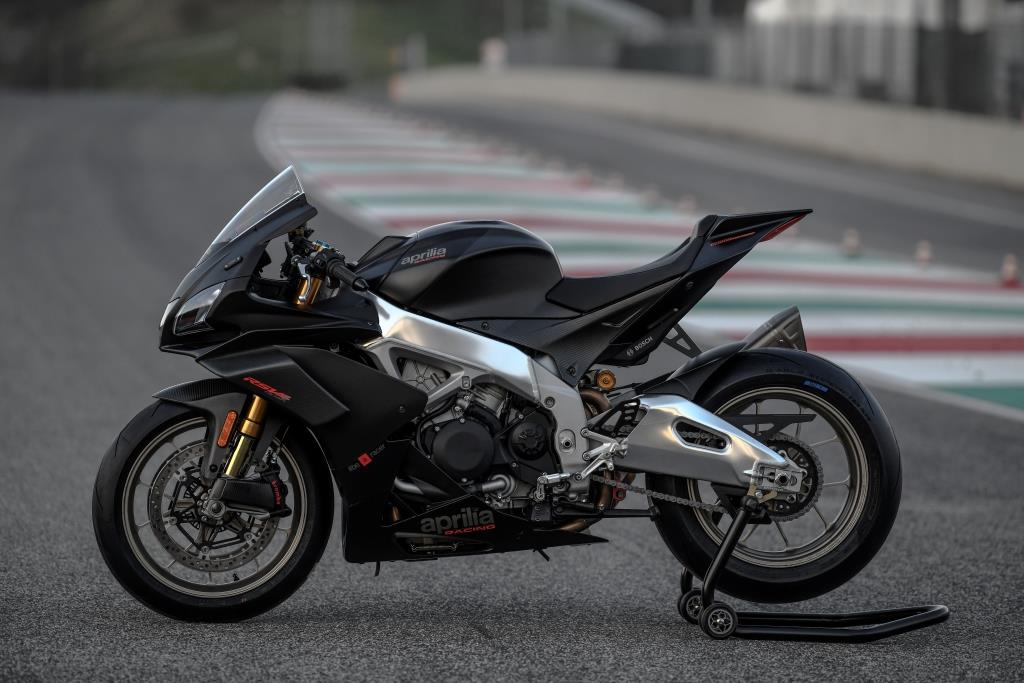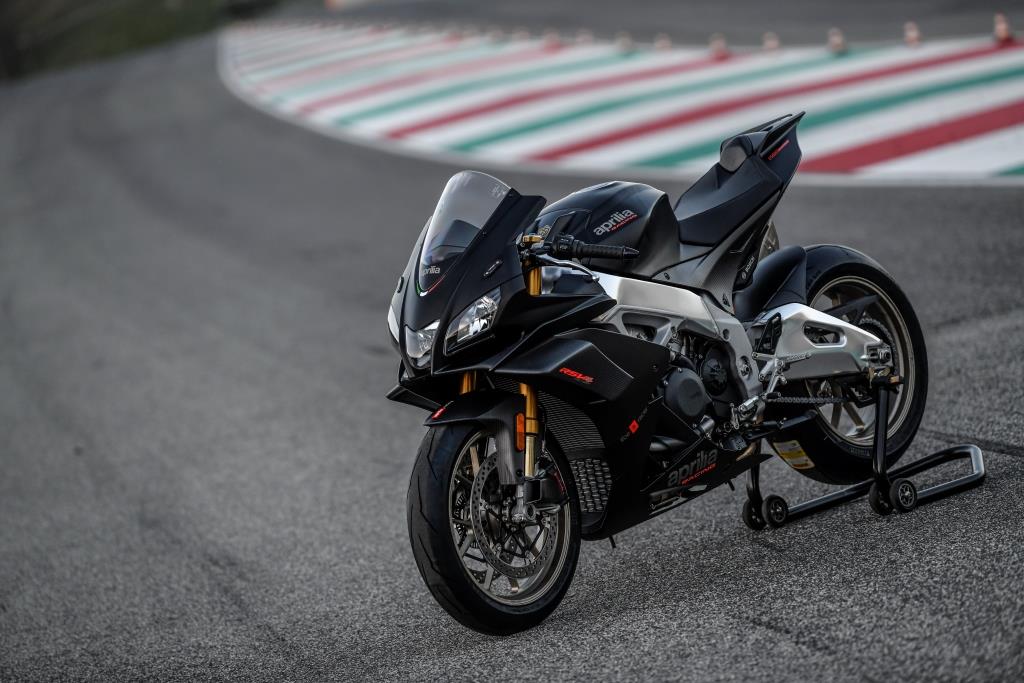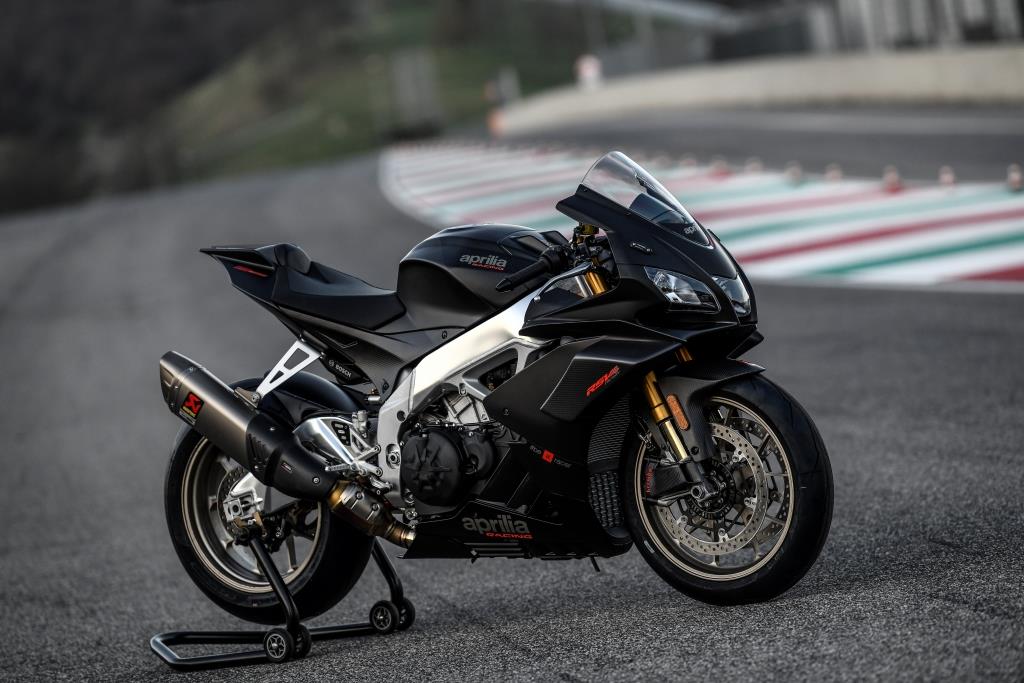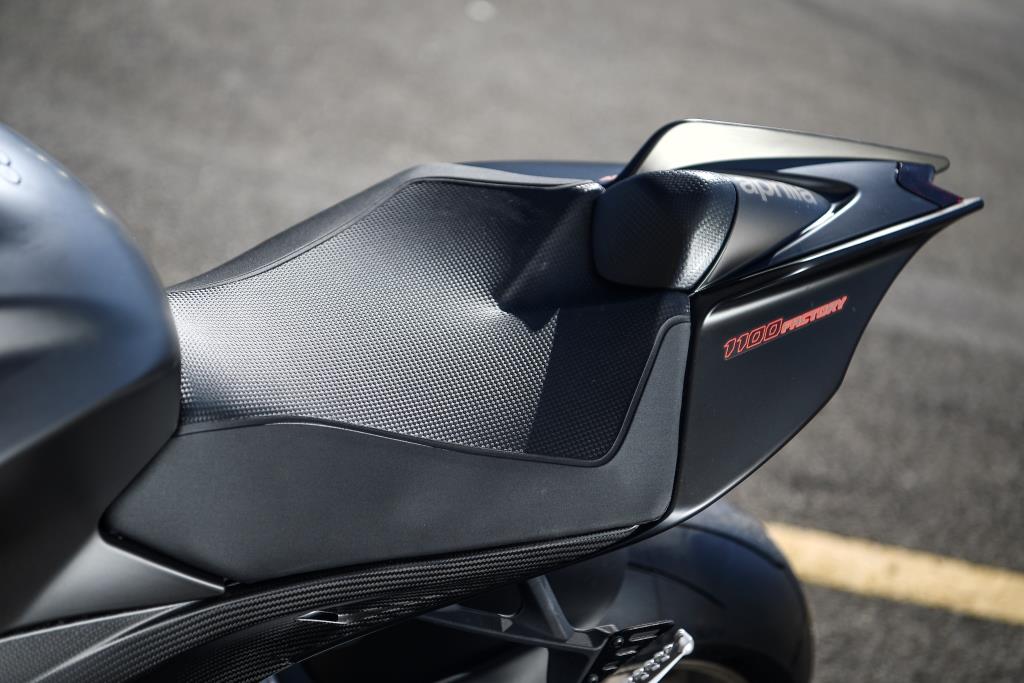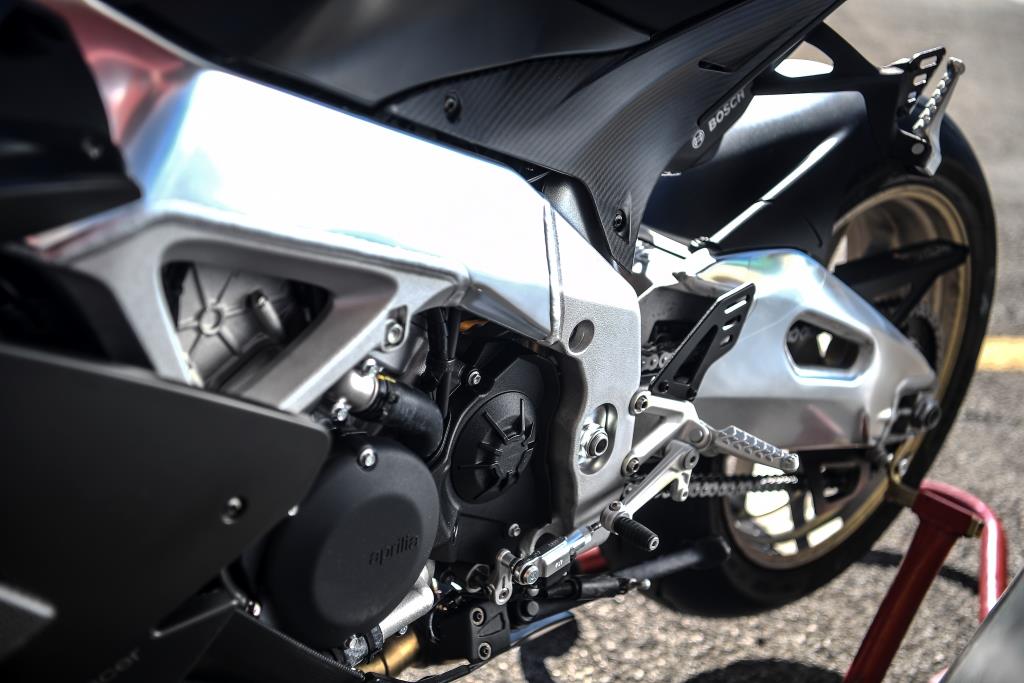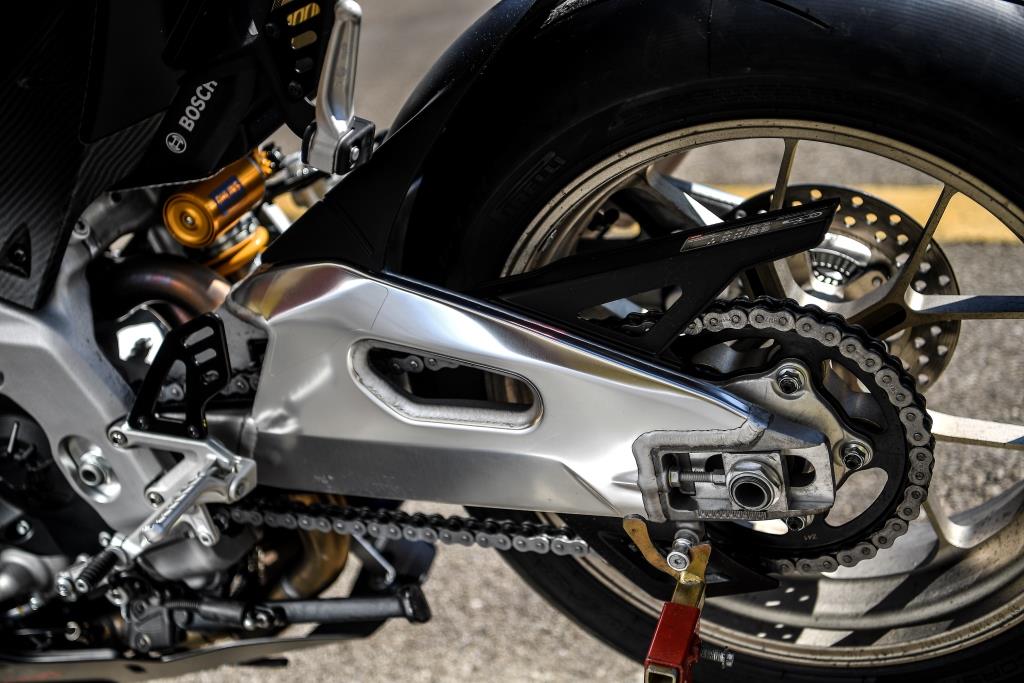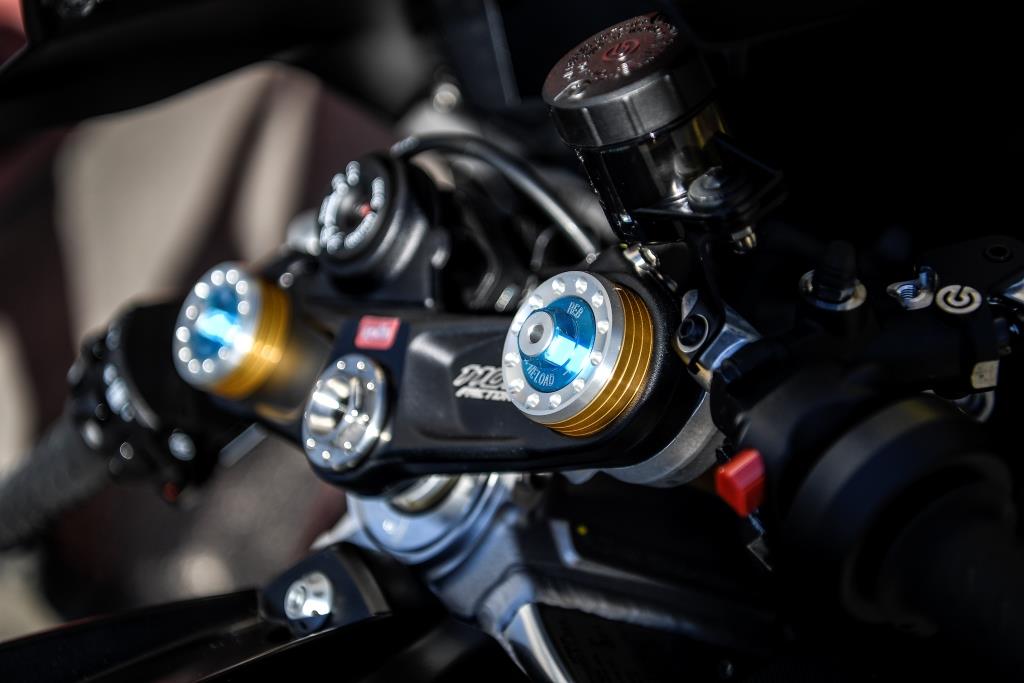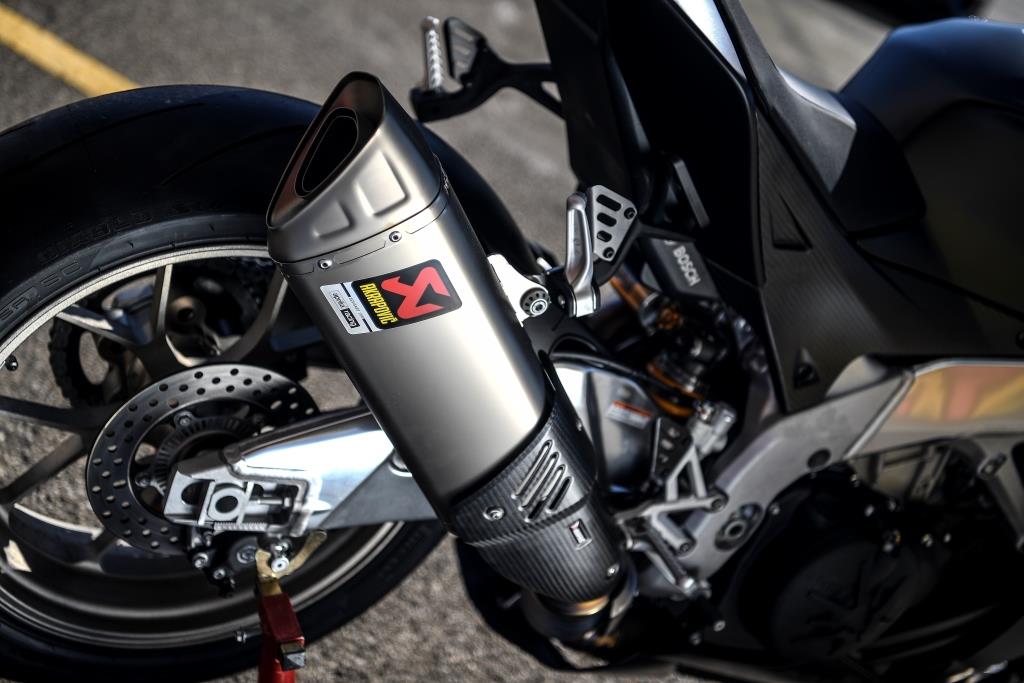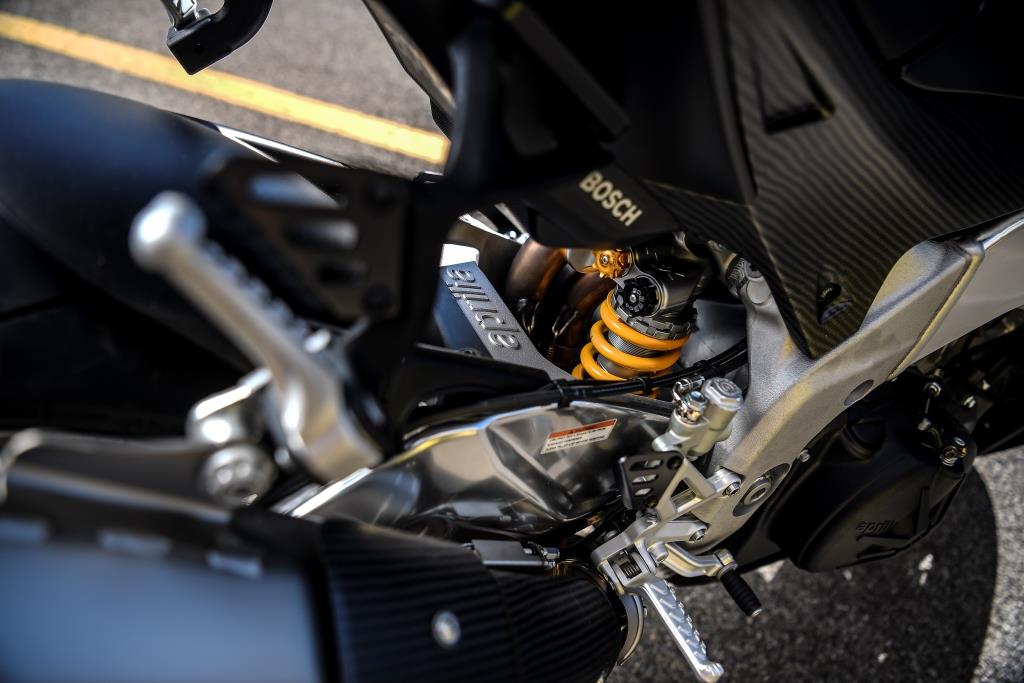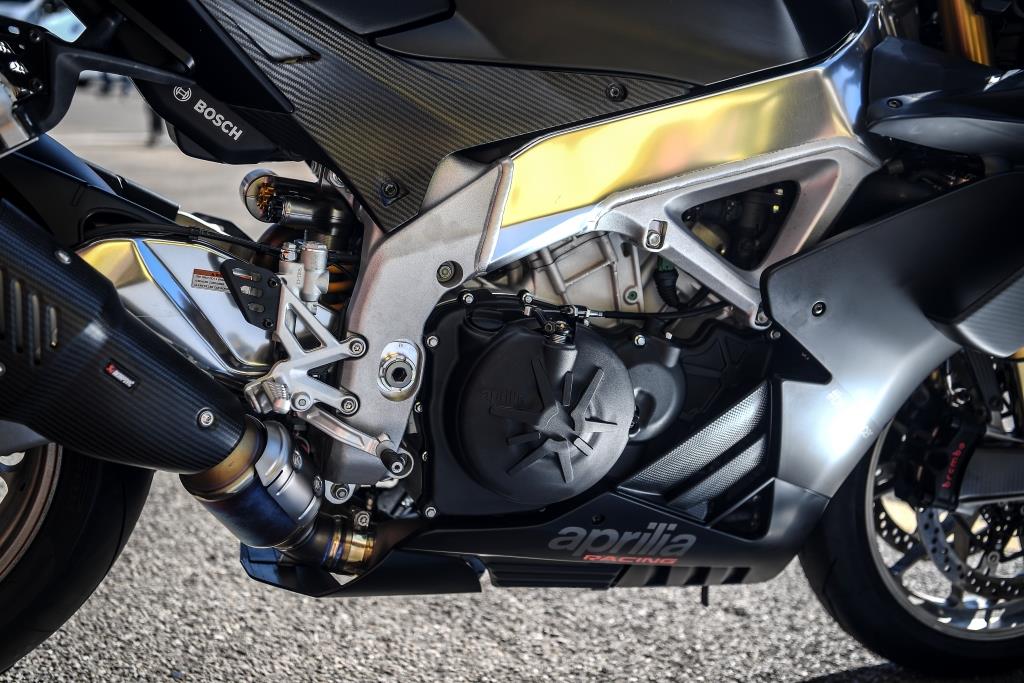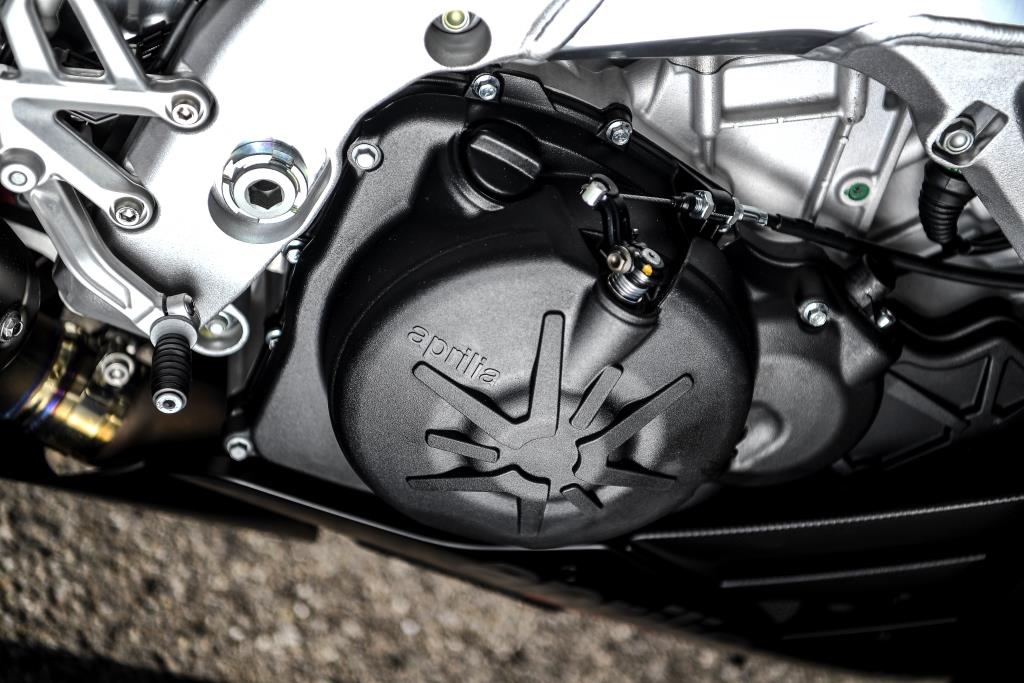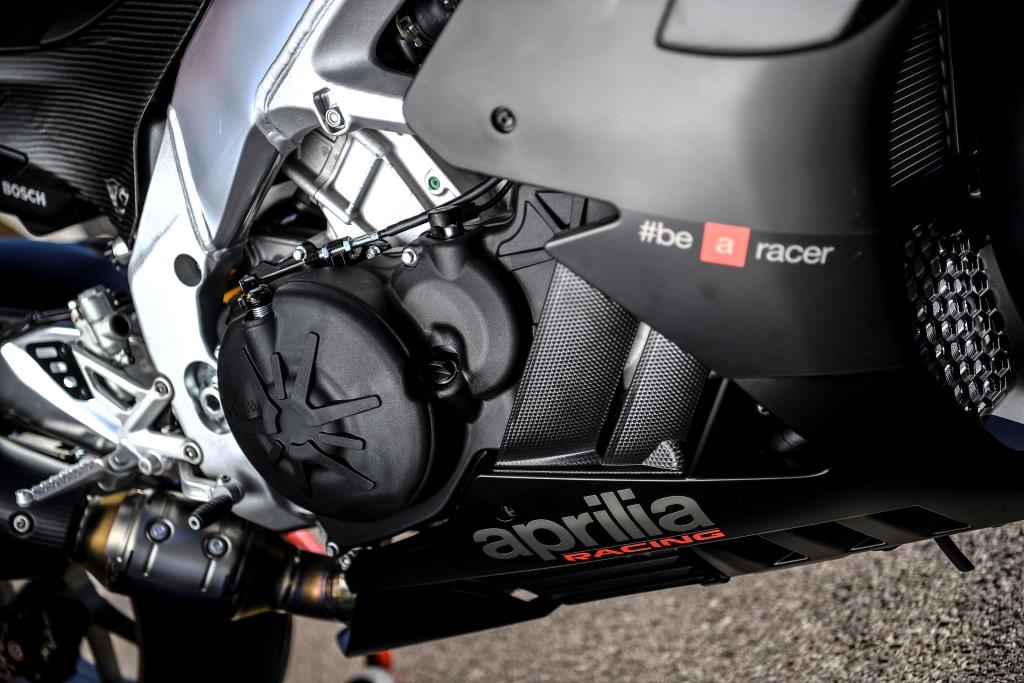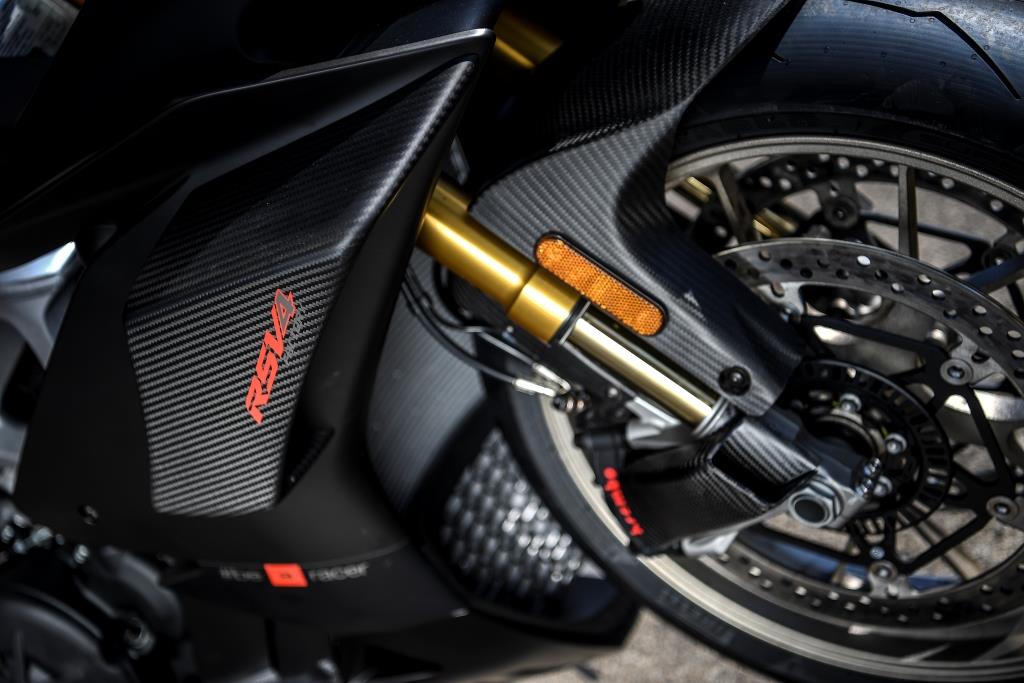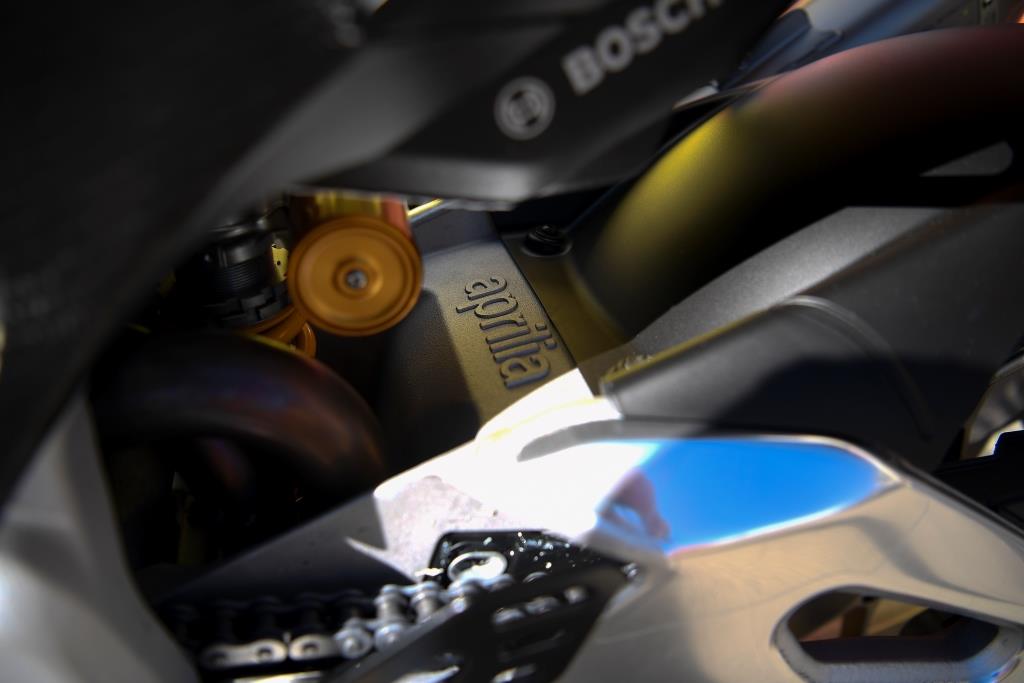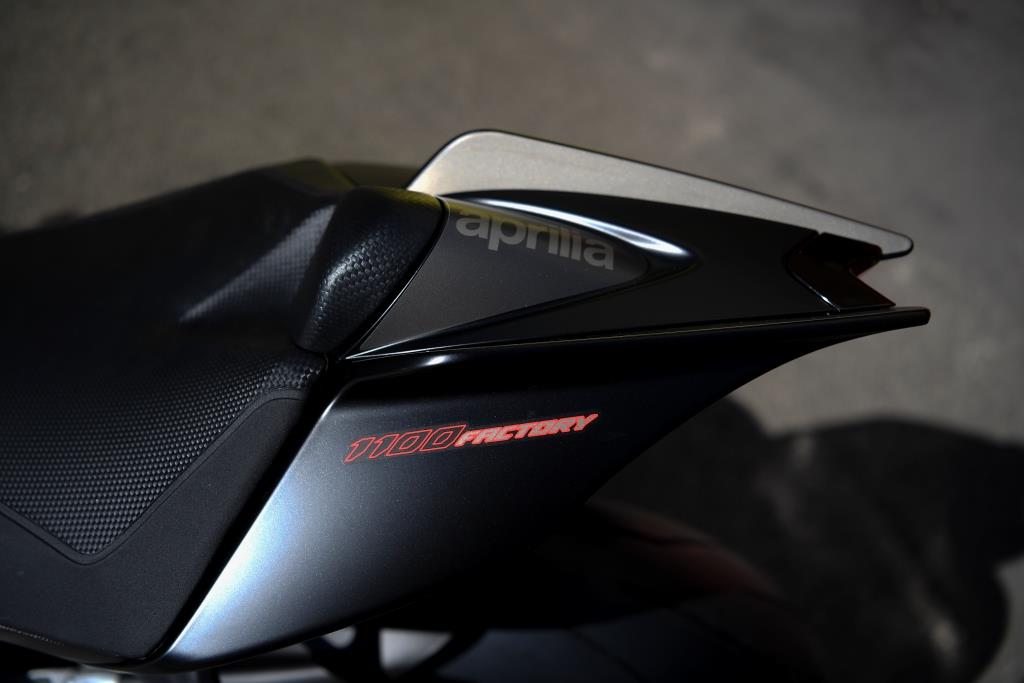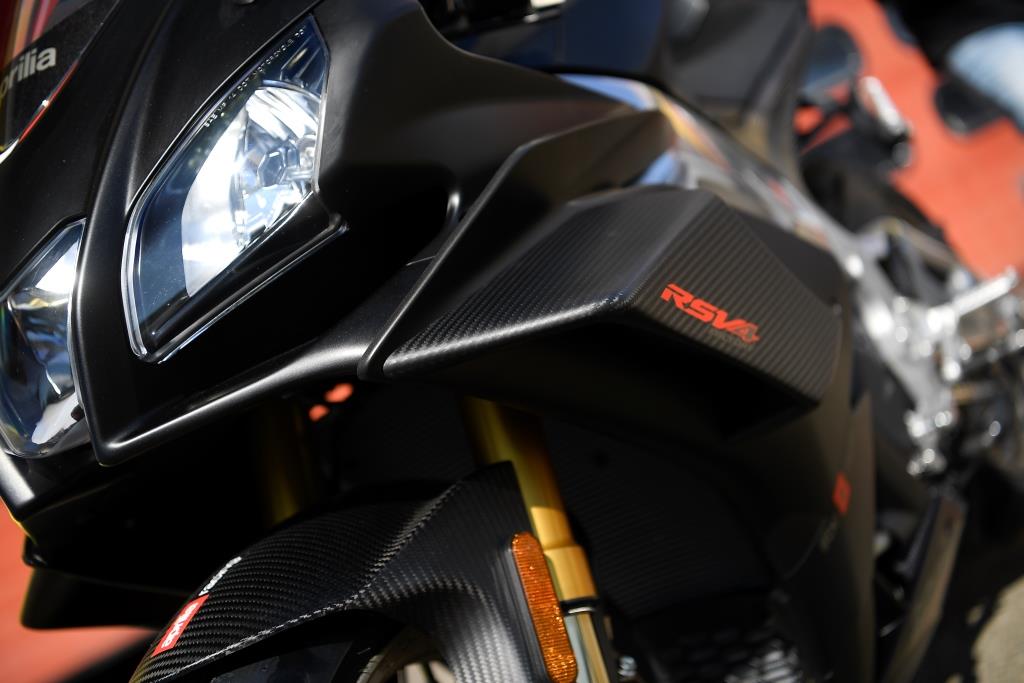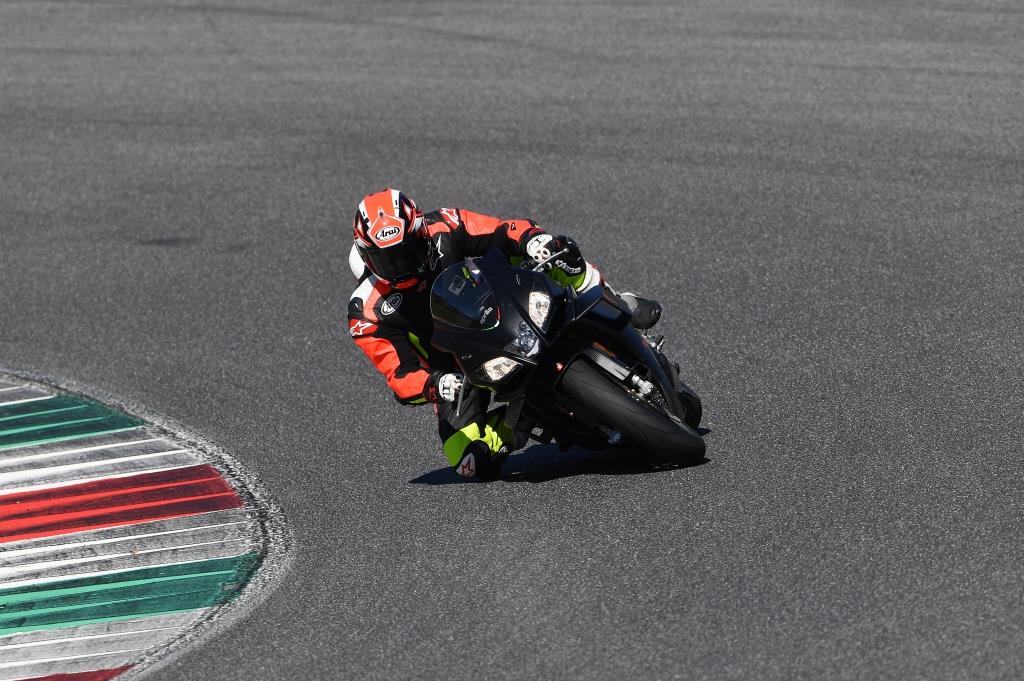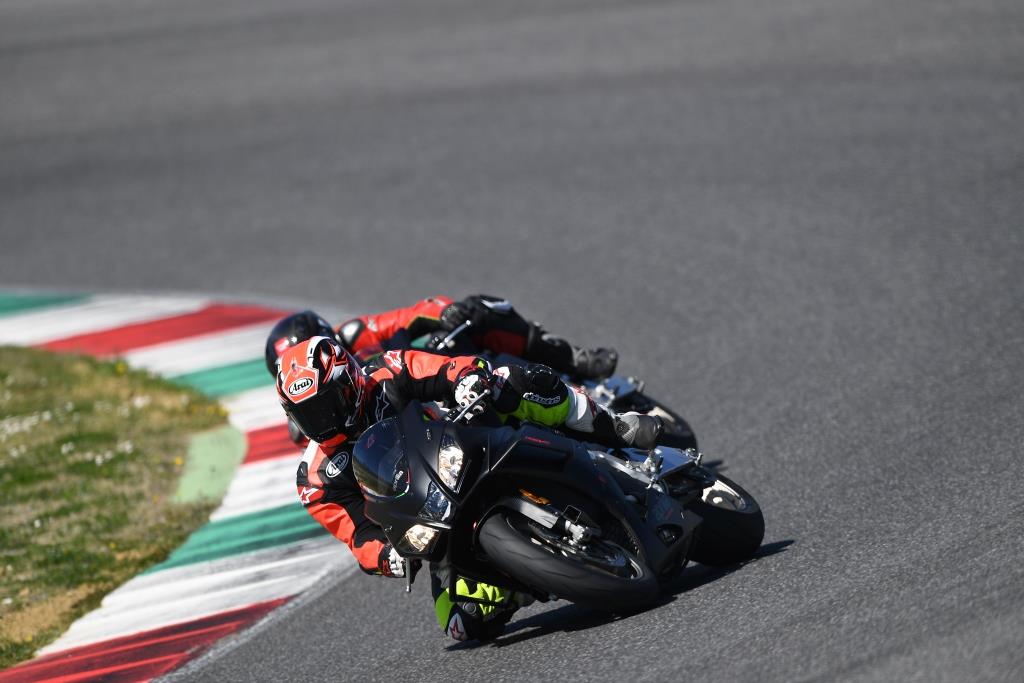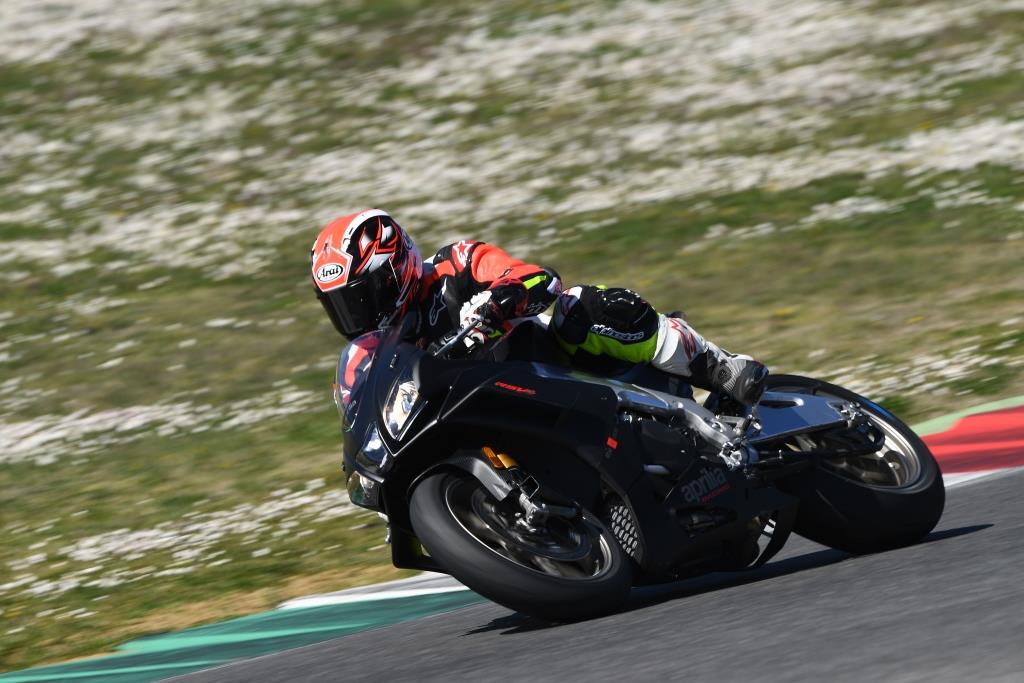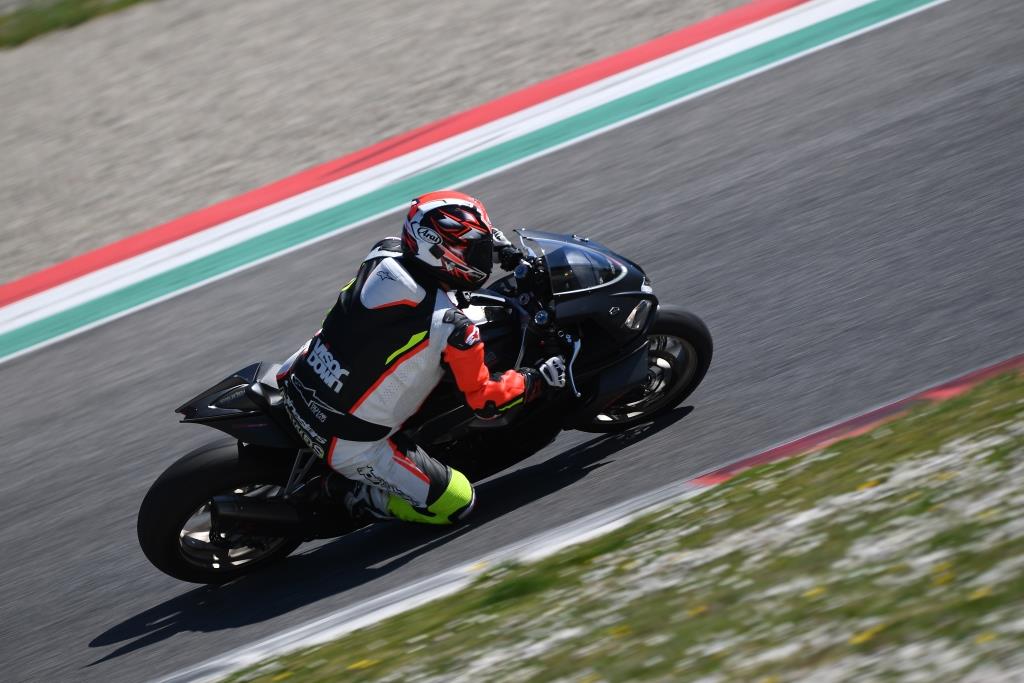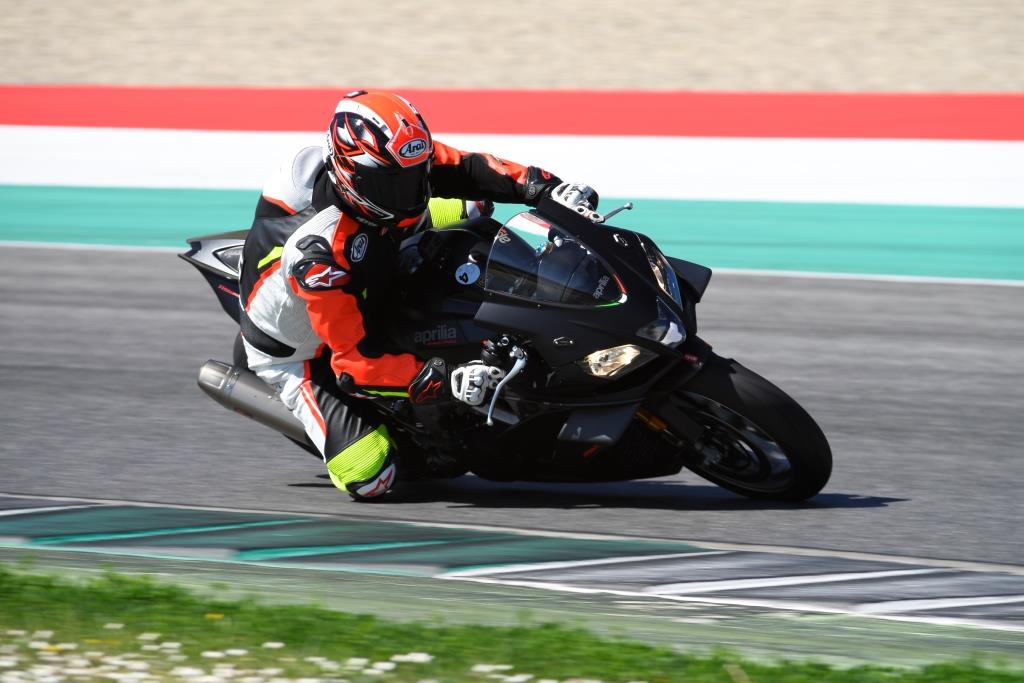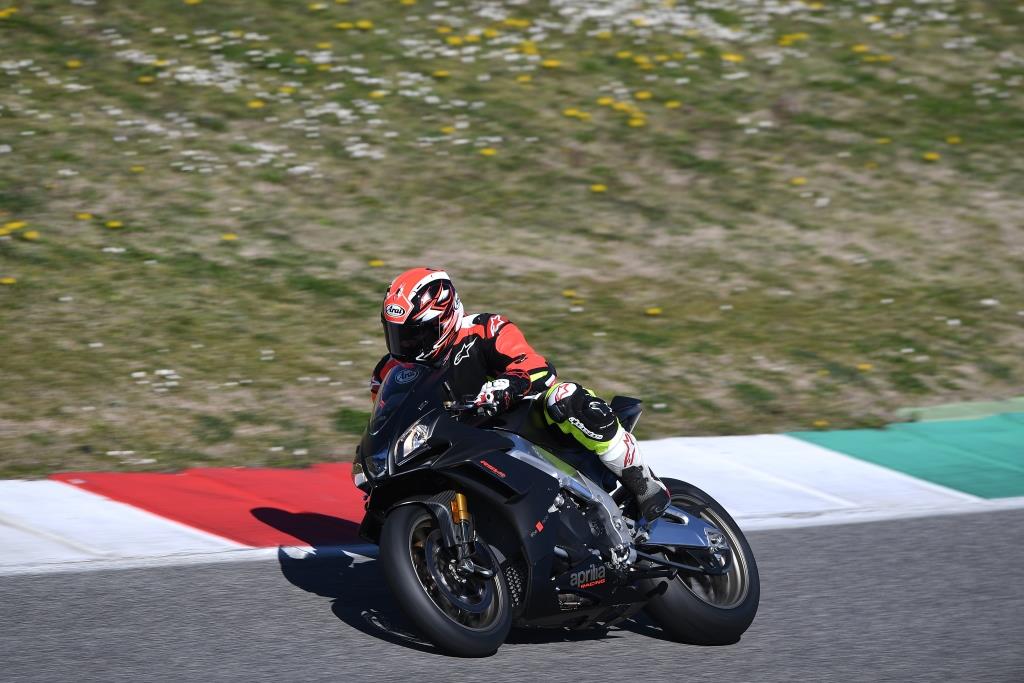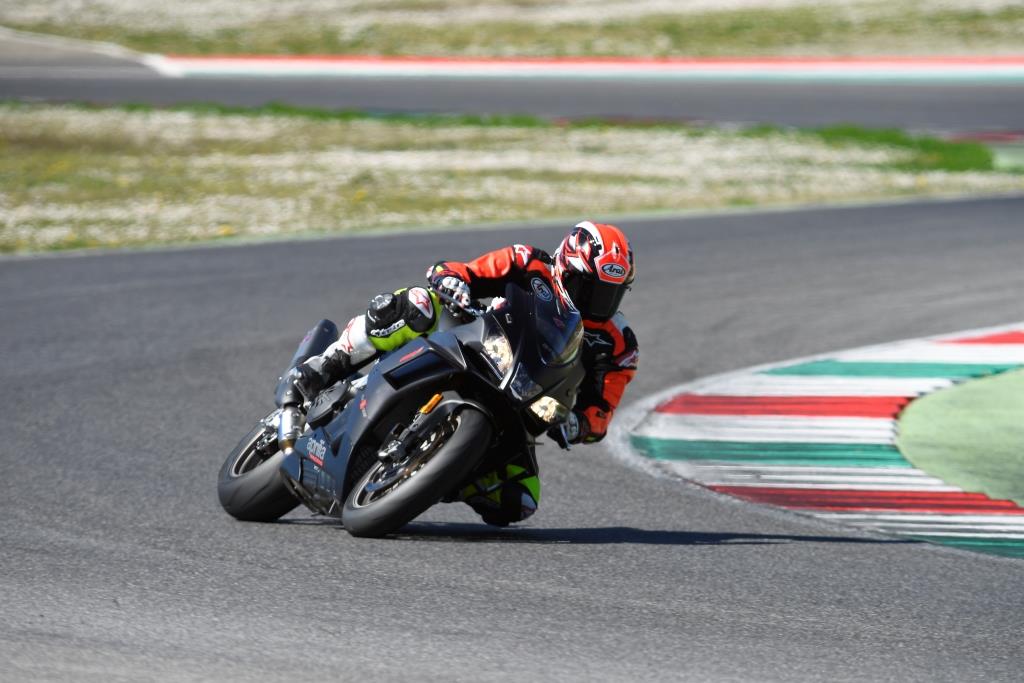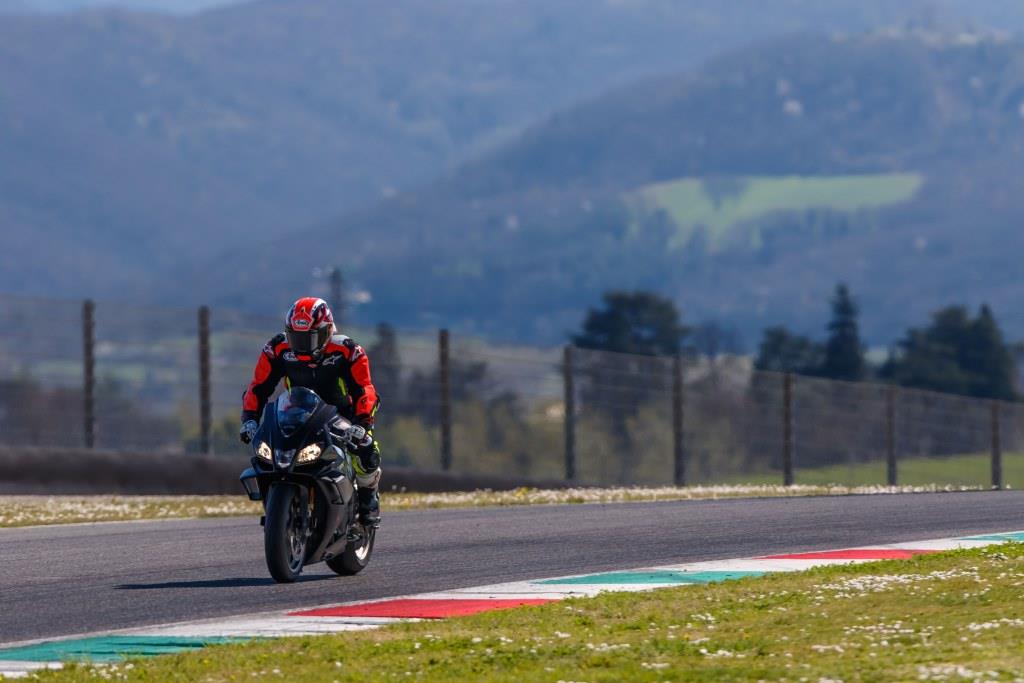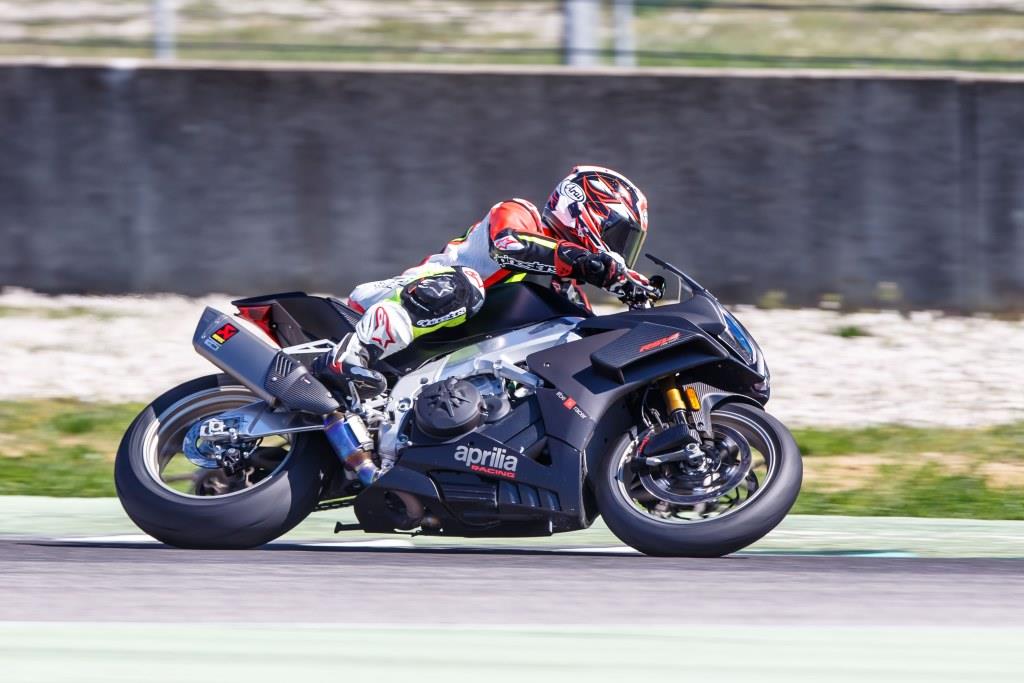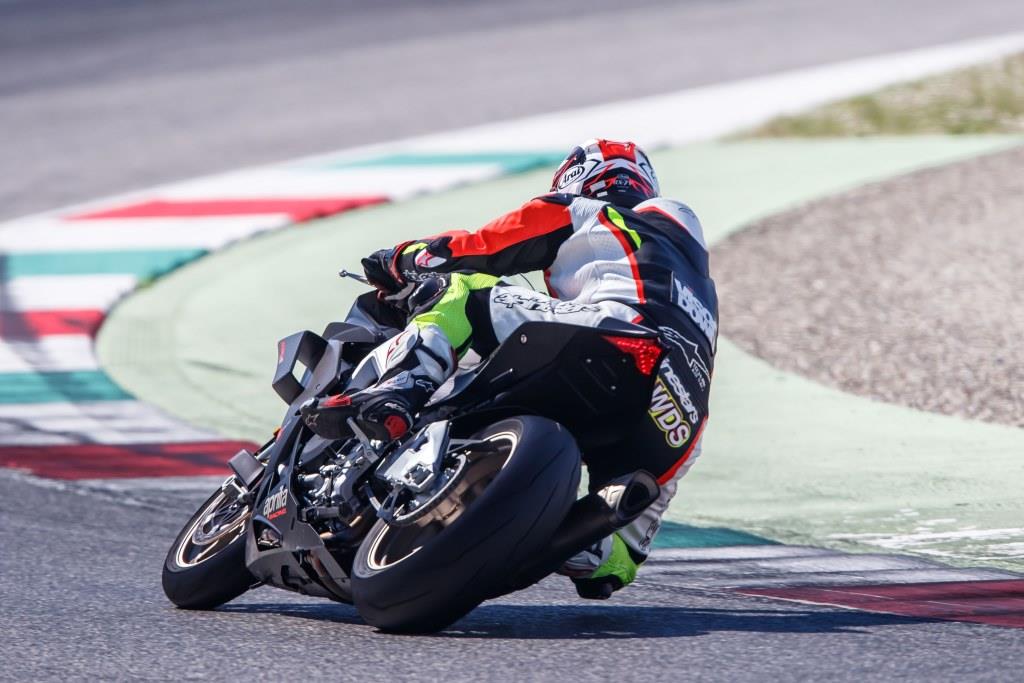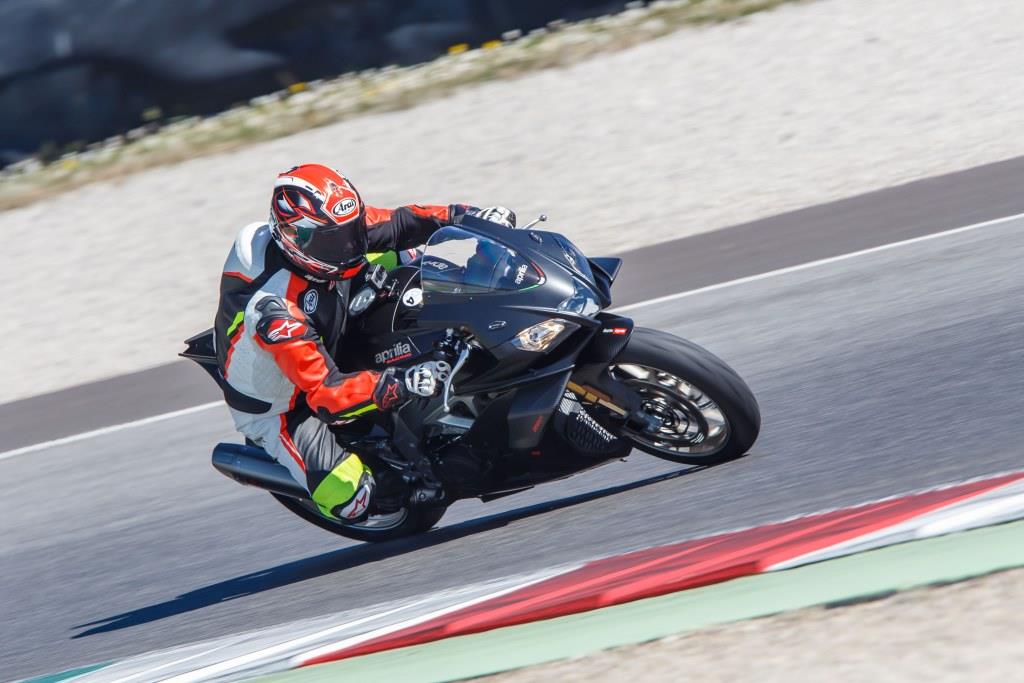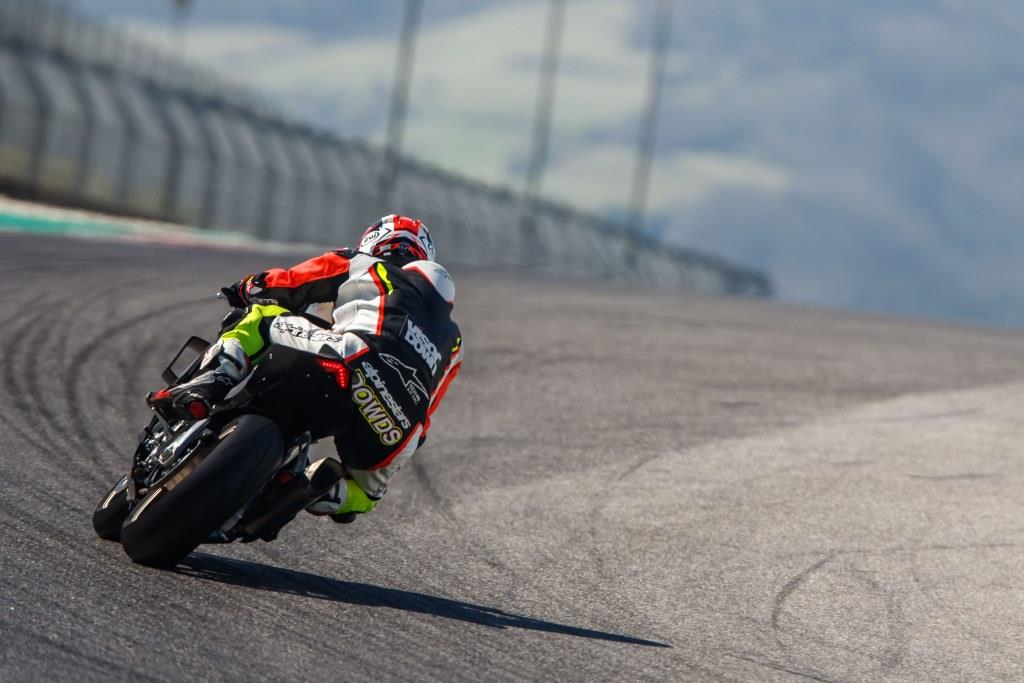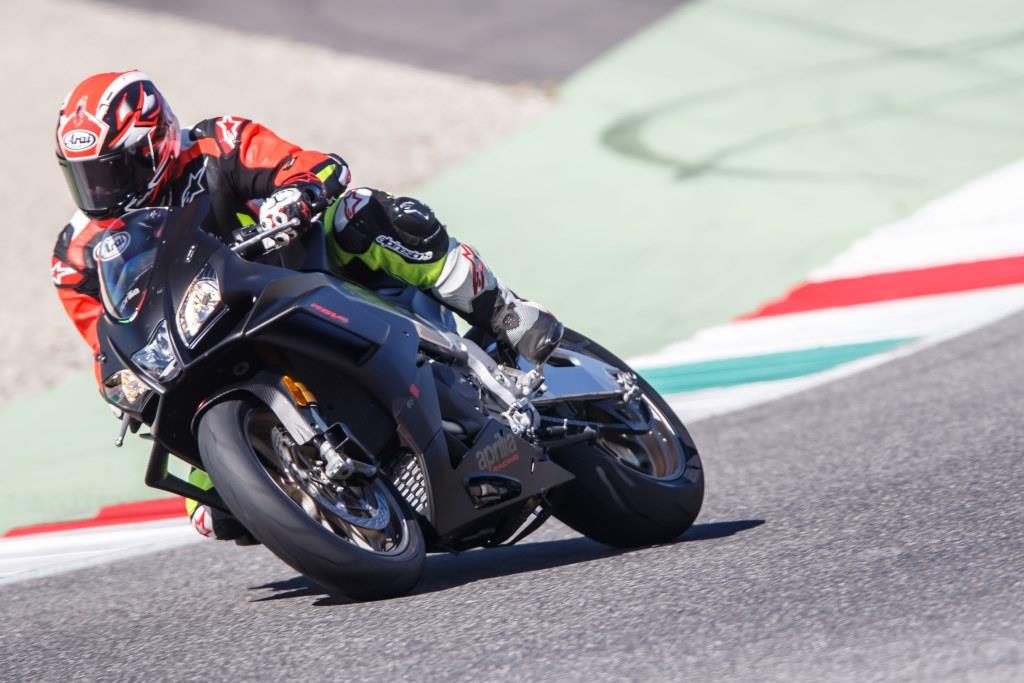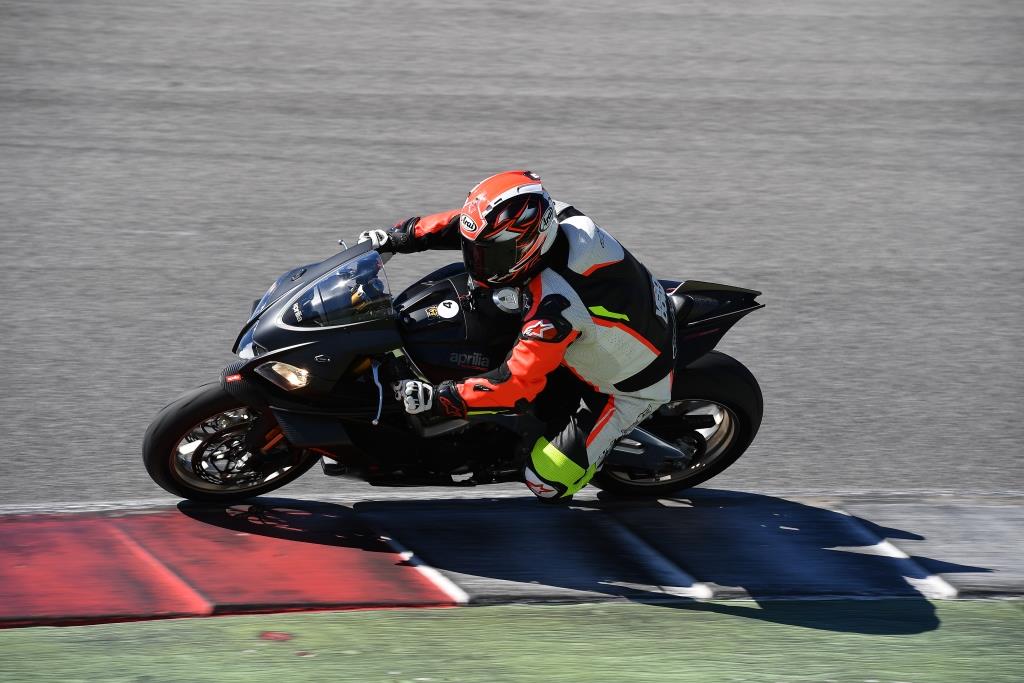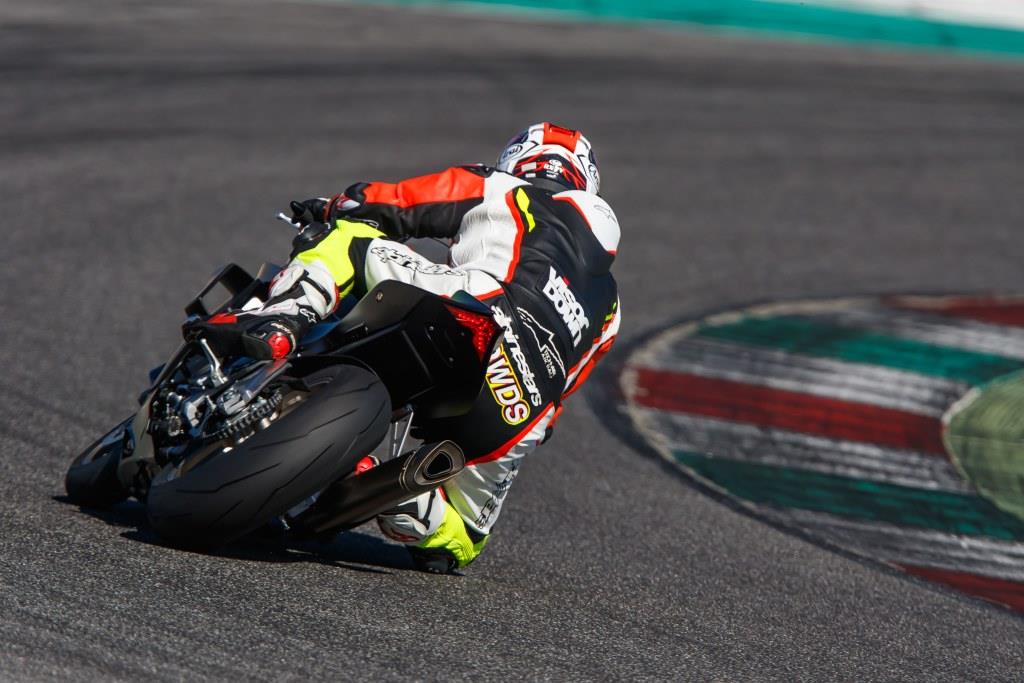Who doesn’t love a bit of Italian passion? Whether it’s their amazing food, great wines, chic fashion or organised crime gangs, you have to admit they do a cracking line in the classy, the evocative and the brutally effective.
And of course that also applies to their cars, their racetracks and their motorbikes. Which brings us to my day out last weekend – wazzing round the Mugello circuit on Aprilia’s new 2019 superbike.
Mugello is one of the legendary European tracks: big, bold, beautiful – and packed with stunning corners. It also boasts a 1.1km straight where the MotoGP guys hit 220mph, and which you could land an A380 Airbus on (probably, if the wind was in the right direction, and you weren’t too heavy) It’s a fabulous place to ride a big bike.
And we’ve got a pretty fabulous big bike to ride round it today – Aprilia’s new RSV4 1100 Factory. The Noale firm has taken its awesome RSV4 superbike, and popped a full-beans 1100 motor in it, bumping up the peak power and torque by around ten per cent, and given the chassis a bit of a makeover at the same time. It’s a bit of a no-brainer move in a couple of ways: Ducati’s 1100cc V4S launched last year and immediately went to the top of the superbike class, thanks to its combination of monstrous power, good looks and slick chassis. So there was a precedent there to follow. And, as luck would have it, Aprilia had an 1100 engine largely ready to go: its Tuono supernaked has had a 1,078cc engine since 2015. A sporty motor overhaul bumped up the compression, added some angry valve timing and fitted an extra set of fuel injectors, to make a 217hp beast. Nice.
The old 999cc RSV4 was a proper weapon, especially on track, so the big question is, has Aprilia gone too far with the extra power? I’m about to find out. We’re in the first riding group, and Aprilia’s not bothering with any of the usual niceties on a track launch – no sighting laps, or smiley test riders taking you round to get into the groove. Nope – the tyre warmers are peeled away from the baking Supercorsas, my bike (in black, like all the 1100 Factorys will be) is slipped off the paddock stands, and I swing a leg over the tall seat. I can just about get a tiptoe down on one side, give the brake lever adjuster a quick twiddle, then I’m off and out down pitlane.
I’m bellowing profanities within one corner. I’ve been to Mugello before, but not for a long time, so while I know where I’m going, roughly, there’s little in the way of precision about my progress. But I very quickly realise that this is a very very serious bike indeed. Out of turn one, heading up the hill, I give the extremely-quick-action twistgrip a big tweak in second gear, and let out an involuntary yelp as it kicks like a pissed mule. It’s an obvious point of course – but this full-beans, 1100cc superbike is stunningly, wildly, almost-obnoxiously fast. Mugello has loads of space to stretch out though, and my jaw drops every lap, as I get myself into the Tuscan track’s groove, and begin to push on a bit harder.
I start out using second gear for a lot of the bends, using the higher revs of the motor, as you would expect on a sportsbike. But it’s all very frantic: I can feel my strength sapping away already, I’m not settled, and I’m quailing a little before the screaming might of the compact V-four motor underneath. The titanium Akrapovic can is emitting a beefy bark and that, combined with the intake roar, makes for a sweet sound – neither twin nor four, but something unique.
I’ve not been paying the chassis too much attention in this first few laps – which is probably a good thing. Aprilia’s claiming slightly tweaked geometry gives better stability while retaining its agility, and it certainly feels nimble and precise, not at all like a big beast. It’s all just letting me settle in nicely at the moment, and despite the pegs being a little high for me, I’m right at home.
Those Brembos though. I get myself a little distracted at one point heading up the hill into turn two, and flip out for a second. Heading for the edge of the track at speed, I unconsciously grab a big old handful of front brake, and my Arai turns into a tiny Tourette’s therapy centre once more. Simply put, the power and bite is stupendous, and like the ¼-turn throttle, you’re able to unleash massive, primeval forces, with the most minimal of inputs.
Just as well at Mugello of course: the main straight speed record is held by Andrea Iannone on his Ducati MotoGP bike in 2016, when he hit a hilarious 355kph, or 220mph. I’m miles behind that of course on the Aprilia, but the LCD dash is still topping 290kph before I hit the anchors, and that huge power is matched by the feel and feedback from the front end. You feel entirely in control, even as the gravel trap looms in your face and the back end starts to get a wee wriggle on. Amazing stuff – and the sort of experience you can only get on a bike like this, in a place like Mugello.
As the sessions go on, the RSV4 just gets better and better. I quickly swap into third gear rather than second for most of the bends, and it’s much better. Riding the beefy 1100 V-four a bit more like a big twin pays dividends: its extra torque is more than up to pulling the higher gears through its stonking midrange, and I’m going round much quicker, yet also smoother and more relaxed.
The chassis is hugely impressive still: Aprilia’s done a brilliant job here, and it’s both rock-solid down the big straight, yet easy to muscle round the complex bends at big speeds. The Pirelli rubber has monster grip, and though the traction light does start to flicker here and there, the combination of warm, dry asphalt and fresh, grippy, hot Pirelli Supercorsa is incredibly tenacious, and gives massive confidence. I remember in the past how we used to praise bikes like the 1998 Yamaha R1, by saying they had the handling of a 600 with the power of a litre bike. Here, though, we have the power of a ZZ-R1400, with *even better* handling than a 600…
My final session of the day is the best. I’ve still got a bit of stamina left, and I’ve really started to get the most impressive part of Mugello: turns 6-9 – Casanova, Savelli, Arrabbiata 1 and Arrabbiata 2. That’s a quick downhill right, into a left, then right back up the hill and finally a blind, rather off-camber right turn at the top of the crest. It’s challenging in all the best ways – a trial of your technical ability, your track knowledge, and a proper bottle test too. Get it right and you grin all the way through the next lap – get it wrong, and you’ll lose a load of time, and possibly end up in the gravel.
The RSV4 1100 Factory is a brilliant partner for the job though: the brakes and front end confidence to push hard into the downhill right-hander, lovely precision to put you right where you want through the complex flowing series of bends, and the strong easy torque to haul you back up the hill again.
I’m almost all out of passion now though. My day is done, and Mugello and the RSV4 1100 have properly drained me. The sheer adrenaline from riding such a massive track, on such a massive performer has been coursing through me all morning, and I need a load of water, some strong Italian espresso, and a bit of a sit down to assimilate it all.
There’s no doubt that Aprilia has made something really, really special here. If I’m being really picky, I don’t agree with the all-black paint job being the only option; but everything else is amazing. The chassis has more than enough capability to take you through years of trackday riding development, while the engine is simply insane. Add in a stonking electronics setup, plus neat details like the carbon brake scoops and the aerodynamic wings, and you have a beguiling, exotic package. A bike which is a very intelligent choice indeed – but is also jammed with Italian passion. What else did you expect?
Engine
The RSV4 1100 Factory’s 65° 16v DOHC V-four lump has many similarities to the 1078cc lump in the firm’s Tuono 1100 supernaked, which has been out for a few years now. The RSV4 shares the 81mm bore and 52.3mm stroke and the 48mm throttle bodies, but has two injectors per cylinder, and a higher compression ratio, now up to 13.6:1. That gives it more revs – peak power is made 2,200rpm higher than the Tuono at 13,200rpm – and more power, up from 175hp to 217hp.
Frame
Aprilia are very proud that they have the only fully-adjustable frame on the market – you can alter the steering head geometry, engine mount position and swingarm pivot point. None of which is of much practical use to anyone below, say, the 95th percentile of club racers – but it is all very cool indeed. It’s unchanged from the 999cc RSV4, but there’s new geometry: 4mm shorter wheelbase, 2mm less fork offset and less rake. The firm reckons this puts more load onto the front tyre, adding stability but maintaining agility.
Suspension
The Noale massive has poo-pooed the trend for fancy electronic bouncers – and stuck to the knitting, with slick Öhlins kit front and rear. No mad FGR gas forks or the like – at this price point you get NIX forks and TTX shock and like it. There’s also an adjustable Öhlins steering damper tucked away in there.
Swingarm
The same as on the 999cc bike – but still a gorgeous piece of kit – hugely braced and massively stiff.
Brakes
Ducati’s had its 12 months of exclusivo use of the latest Brembo Stylema calipers, so now Aprilia can get its mitts on them. The big benefit from these is light weight, and loads of ventilation channels, bringing cooling airflow to the pad surfaces. Aprilia’s expanded that with a set of carbon-fibre cooling ducts which were on all the test bikes we rode. They’re apparently a £300 option, but we’d be demanding them thrown in when buying a bike – they add a stack of trick coolness, as well as the brake cooling improvements. The 330mm front discs are also by Brembo, and the combination provides spectacular performance.
Electronics
Aprilia’s been at this for a while – its APRC setup was amongst the first fully-integrated rider aids packages. Having said that, there are no big advances for 2019 – the colour LCD dashboard is a bit brighter seems to be about it for system upgrades. The traction control, ABS, engine braking, power delivery and wheelie control can all be fiddled with easily via the clever mini-joystick on the switchgear, and there are three power modes – road, track and race. If you can’t get a good setup to suit you here, we give up!
Aero management
The RSV4 1100 now comes with wings – a pair of carbon aerofoils attached to the fairing sidepanels. They apparently give 8kg extra downforce at 300kph, which might not sound a lot, but their position forward and low-down will aid stability at speed, pushing the front end down just when you need it.
SPECS
Price: £21,499
Engine: DOHC 16v, 65° V-four, l/c, 1,078cc
Bore x stroke: 81×52.3mm
Compression ratio: 13.6:1
Carburation: four 48mm Marelli throttle bodies, eight injectors, ride-by-wire
Max power (claimed) 217hp@13,200rpm
Max torque (claimed) 89ft lb@11,000rpm
Transmission: six speed cassette gearbox, wet slipper clutch, chain drive
Frame: composite aluminium twin-beam. Swingarm pivot point, steering head/rake and engine mounts all adjustable
Front suspension: 43mm USD Öhlins NIX fork, fully adjustable
Rear suspension: aluminium braced swingarm, fully adjustable Öhlins TTX monoshock
Brakes: twin 330mm discs, four-piston Brembo Stylema radial calipers (front), 220mm disc, twin-piston caliper (rear), cornering ABS.
Wheels/tyres: machined forged aluminium)/Pirelli Supercorsa SC1, 120/70 17 front, 200/55 17 rear
Rake/trail: 24.5°/103.8mm
Wheelbase: 1,439mm
Kerb weight: 199kg
Fuel capacity: 18.5 litres
Equipment: APRC (Aprilia Performance Ride Control) IMU-based traction control and cornering ABS, with wheelie control, launch control etc, all individually adjustable, and three pre-set riding modes. Cruise control, TFT colour dash, up/down quickshifter, pitlane speed limiter.
